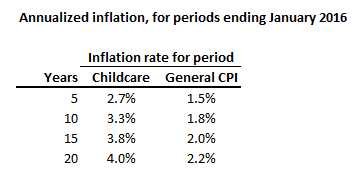![https://commons.wikimedia.org/wiki/File%3AUS_Navy_050114-N-3659B-050_he_Morale_Welfare_and_Recreation_Child_Development_Center_on_board_Naval_Support_Activity_Mid-South_in_Millington%2C_Tenn.%2C_provides_daycare_services.jpg; By U.S. Navy photo by Photographer’s Mate 3rd Class Joseph M. Buliavac [Public domain], via Wikimedia Commons](https://wp-media.patheos.com/blogs/sites/533/2016/05/1024px-thumbnail-1024x667.jpg)
Affordable healthcare . . .
Affordable housing . . .
Affordable tuition . . .
And now, affordable child care. Ever notice how “affordable” now means “government subsidized”?
Hillary Clinton has now proposed a new government program, the objective of which is to subsidize child care to according to the principle that no family should pay more than 10% of their income for child day care expenses. At the same time, this would be paired with a set of incentives for child care centers to raise pay for their workers to the level of kindergarten teachers. She did not specify how either of these elements would be funded, or how the government would control pay scales for private workers (perhaps some decree to retain eligibility for government funds such as the lunch program?).
See reports from the Huffington Post and Politico, and commentary from the Washington Post and the Wall Street Journal (google search terms RAISE initiative child care).
And, incidentally, a chart was floating around the other day showing that the cost of child care + university tuition was skyrocketing, but it was rather senseless to combine these two. Here’s the CPI data on childcare costs, compared to general inflation (yes, this isn’t the BLS site, but it’s where I landed via google and perfectly suitable for the purpose), and here’s a quick table:

Now, clearly, daycare costs are rising at levels greater than general CPI, and that really shouldn’t be a surprise, as expectations for daycare have similarly increased: even without government mandates or incentives, parents are looking for “high quality” programs. What’s more, costs are very heavily due to employee wages, so, even though wages have stagnated recently, it’s reasonable for childcare costs to outpace general inflation, since there’s little to be gained in the way of productivity, just a minimal amount of improvement in back-office functions.
But what would daycare look like if it was massively subsidized by the government?
A straightforward Obamacare-like subsidy that limits family cost to 10% of salary would, for most families, wholly remove financial incentives from childcare provider decisions. If the feds pay the difference whether you select an in-home daycare or The Goddard School, you’d choose The Goddard School, no? And the number of families whose income is high enough that they’d still be paying full cost in any case is likely a relatively small enough proportion that the families with no cost incentive would spark a rush towards higher fees funding higher salaries, fancier facilities, longer hours, and, of course, higher profits for owners. One could imagine two tiers of childcare, those attended by voucher-families, and those attended by pay-your-own-way families – but there’s likewise a good chance that it would simply become the norm that everyone pays 10%. (And how’s the 10% determined? Based on only the custodial parent, or adding in both parents’ income?)
Of course this wouldn’t be sustainable, would it? It’d be like college tuition subsidies, except to a more extreme degree, as it wouldn’t be a matter of just some families shrugging off the cost as covered by income-based loans, but nearly all families doing so.
So presumably, the feds would establish a maximum reimbursement level. Heck, they already do, when it comes to daycare benefits for poor families. Here are the rates in Illinois: $46.49 for up to a twelve hour day for an infant in the Chicago area, lower for other ages and locations. That’s $12,000 per year, which seems generous but full-time care at the local Kindercare is now up to $389 per week, or $78 per day, or $20,000 per year. (I dug up the tuition rate sheet from 2007 for comparison, which was still tucked away in a folder, and it was $298 then; seems like a huge jump but it’s exactly 3% per year.) Do they offer discounts to families on vouchers? I don’t know, but, persumably, even if they do so now, they couldn’t possibly do so if everyone was using a voucher.
Which would mean that “middle class” reimbursement levels would have to be set much, much higher, especially if they want to set caregiver pay higher as well. How do they determine the right level? Perhaps this would effectively mean that daycares would function more like regulated utilities, with permitted reimbursement levels growing as different criteria are met, and with set criteria required for basic eligibility, including not just the existing metrics of caregiver: child ratios and other regulations having to do with health and safety, but requirements regarding payroll levels, staff turnover and credentials, submission of planned curriculum, etc. How would they determine the “right” reimbursement level for a center to meet all their metrics and still stay in business? That’s the trick, isn’t it? Do they go for generous funding, or risk levels low enough that they can’t get enough people to hang up their shingle in the first place?
But the bottom line would be that daycare costs would be whatever the government decrees them to be, unless the government subsidy buys so little as to be useless.
And, no matter what, this would mean that home daycares would pretty much disappear, given that the government and NGOs already have it as their stated policy that “high quality child care” is by definition provided in an institution, where children are separated by age into “classrooms,” where the days are tightly structured, with reading lessons added in for the 3s and 4s.
In fact, back in September, I wrote about the Center for American Progress’s proposal for a broadly-available “high quality child care tax credit,” which was intended to move families to institutional daycare. The strange thing about this proposal is that it envisioned a total cost of $14,000 per child, much lower than Kindercare’s $20,000, though, to be sure, that was for infant care in a high cost area.
So, bottom line: massive increase in child care cost, paired with massive shift in who pays, from a parental responsibility to make decisions as a family, with assistance for the poor, to another social welfare program.
Image: https://commons.wikimedia.org/wiki/File%3AUS_Navy_050114-N-3659B-050_he_Morale_Welfare_and_Recreation_Child_Development_Center_on_board_Naval_Support_Activity_Mid-South_in_Millington%2C_Tenn.%2C_provides_daycare_services.jpg; By U.S. Navy photo by Photographer’s Mate 3rd Class Joseph M. Buliavac [Public domain], via Wikimedia Commons












